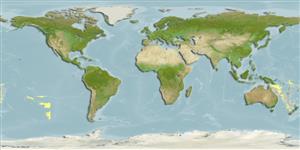Élasmobranches (requins et raies) (sharks and rays) >
Squaliformes (Sleeper and dogfish sharks) >
Squalidae (Dogfish sharks)
Etymology: Squalus: Genus name from Latin 'squalus' meaning shark (Ref. 6885, 27436); notocaudatus: Name from Latin 'nota' for mark and 'cauda' for tail, referring to the dark bar on the caudal fin..
More on authors: Last, White & Stevens.
Environment: milieu / climate zone / depth range / distribution range
Écologie
marin; profondeur 225 - 454 m (Ref. 58440). Tropical
Western Pacific: Queensland, Australia.
Taille / Poids / Âge
Maturity: Lm ? range ? - ? cm
Max length : 61.9 cm TL mâle / non sexé; (Ref. 58440)
Description synthétique
Morphologie | Morphométrie
This species in the 'highfin megalops group' is distinguished by the following set of characters: abdomen depth 8.6-11.1% TL; pre-vent length 45.3-46.5% TL, 1.9-2.0 times dorsal caudal margin; pre-second dorsal length 3.6-4.0 times pectoral-fin anterior margin, 2.4-2.6 times dorsal caudal margin; head width 1.4-1.6 times abdomen width; preoral length 2.8-3.2 times the horizontal prenarial length, 8.4-9.5% TL; head length 3.8-4.3 times its eye length;
mouth width 3.4-4.3 times the length of upper labial furrow; interorbital width 1.4-1.5 times the horizontal preorbital length; fifth gill slit height 1.9-2.1% TL; strongly bifurcated anterior nasal flap; first dorsal fin upright, upper posterior margin almost vertical, greatest concavity closer to free rear tip than fin apex; posterior margin of second dorsal fin deeply concave; second dorsal-fin spine with a broad base; pectoral fin of adult weakly falcate, anterior margin long, 14.6-16.4% TL; both dorsal and ventral surfaces are pale; dorsal fins pale with obvious dark
tips; first dorsal-fin spine and base of soft portion of dorsal fin both pale; caudal fin with broad white posterior margin; prominent dark, diagonal subterminal streak parallel to the upper posterior margin; flank denticles strongly tricuspid; monospondylous centra 47-49, precaudal
centra 94-97, total centra 123-127 (Ref. 58440).
Life cycle and mating behavior
Maturité | Reproduction | Frai | Œufs | Fécondité | Larves
Distinct pairing with embrace (Ref. 205).
Last, P.R., W.T. White and J.D. Stevens, 2007. New species of Squalus of the 'highfin megalops group' from the Australasian region. p. 39-53. In P.R. Last, W.T. White and J.J. Pogonoski Descriptions of new dogfishes of the genus Squalus (Squaloidea:Squalidae). CSIRO Marine and Atmospheric Research Paper No. 014. 130 p. (Ref. 58440)
Statut dans la liste rouge de l'IUCN (Ref. 130435)
Menace pour l'homme
Harmless
Utilisations par l'homme
Plus d'informations
PaysZones FAOÉcosystèmesOccurrencesIntroductionsStocksÉcologieRégime alimentaireÉléments du régime alimentaireConsommation alimentaireRation
Taille/ÂgeCroissanceLongueur-poidsLongueur-longueurFréquences de longueursMorphométrieMorphologieLarvesDynamique des populations larvairesRecrutementAbondanceBRUVS
RéférencesAquacultureProfil d'aquacultureSouchesGénétiqueElectrophoresesHéritabilitéPathologiesTraitementNutrientsMass conversion
CollaborateursImagesStamps, Coins Misc.SonsCiguateraVitesseType de nageSurface branchialeOtolithesCerveauxVision
Outils
Articles particuliers
Télécharger en XML
Sources Internet
Estimates based on models
Preferred temperature (Ref.
123201): 8.7 - 17.5, mean 13 °C (based on 25 cells).
Phylogenetic diversity index (Ref.
82804): PD
50 = 0.5000 [Uniqueness, from 0.5 = low to 2.0 = high].
Bayesian length-weight: a=0.00339 (0.00162 - 0.00707), b=3.10 (2.93 - 3.27), in cm total length, based on LWR estimates for this Genus-body shape (Ref.
93245).
Niveau trophique (Ref.
69278): 4.2 ±0.3 se; based on size and trophs of closest relatives
Résilience (Ref.
120179): Faible, temps minimum de doublement de population : 4,5 à 14 années (Preliminary K or Fecundity.).
Fishing Vulnerability (Ref.
59153): Moderate vulnerability (45 of 100).
